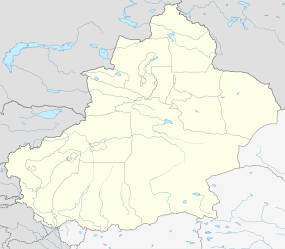Huiyuan, Xinjiang
Coordinates: 44°03′N 80°52′E / 44.050°N 80.867°E
| Huiyuan | |
|---|---|
| Town | |
 Huiyuan Location in Xinjiang | |
| Coordinates: 44°03′N 80°52′E / 44.050°N 80.867°E | |
| Country | China |
| Province | Xinjiang |
| Prefecture | Ili Kazakh Autonomous Prefecture |
| County | Huocheng County |
| 20564 | |
The town of Huiyuan (simplified Chinese: 惠远镇; traditional Chinese: 惠遠鎮; pinyin: Huìyuǎn Zhèn) is located within Huocheng County, in the Ili Kazakh Autonomous Prefecture, Xinjiang, China. It is situated close to the Ili River, some 30 kilometres (19 mi) to the west of Yining, the main city of the prefecture, and some 8 kilometres (5.0 mi) south of Shuiding, the county seat. As of the 2000 census, Huiyuan's population was reported as 20,564.
Between 1762 and 1866 the Huiyuan Fortress, or Huiyuan City (惠远城, Huìyuǎn Chéng), the center of the Chinese authority in Xinjiang was located within the area of the modern Huiyuan town.
History
Qing dynasty
Once the homeland of Dzungar Mongols, this area was annexed by the Manchus after 1761. Huiyuan fort was built in 1762 during the reign of the Qianlong Emperor at the time of one of the rebellions of the local Muslim population. It acted as the center of Manchu military power and civilian administration in Xinjiang. The main fortress of the "Nine Forts" of Ili (see Ili Kazakh Autonomous Prefecture#Qing dynasty for the history of the region), Huiyuan was the seat of the Governor-general of the region, the General of Ili[1]
Huiyuan suffered severe damage during the Muslim Rebellion of the 1860s. Besieged in his palace, the then General of Ili, Mingsioi, blew himself up rather than surrender to the rebels. The fort fell into disuse during the Russian occupation that followed in 1871-81.
The Russians left pursuant to the 1881 Treaty of Saint Petersburg (1881), then in 1883 the fortress and the adjunct military-administrative town were rebuilt in Suiding (now known as Shuiding), some 10 kilometres (6.2 mi) north of the river.
While the city of Yining (originally known as Níngyuǎn Chéng, 宁远城) has remained the commercial center of the region, the 19th century Huiyuan, like its successor Suiding, was mostly a fortress and an administrative town. Huiyuan was known to the Russians and Westerners as the New Kuldja, Chinese Kuldja, Manchu Kuldja, or Ili, to distinguish it from Yining (the Old Kuldja or the Taranchi Kuldja).
Present
James Millward, writing in 1998, said that the only surviving remains of the Qing era structures were a drum tower and a section of the wall that used to enclose the Jiangjun's yamen.[1] However, it has been reported that some of the Qing period buildings, including a bell tower and a "Governor General's Pavilion", have since been rebuilt at the Huiyuan site as a tourist attraction, often referred to as the "Huiyuan Old Town" (惠远古城)[2]
Notes
- 1 2 Millward, James A. (1998), Beyond the pass: economy, ethnicity, and empire in Qing Central Asia, 1759-1864, Stanford University Press, pp. 77–79,277, ISBN 0-8047-2933-6
- ↑ ,
References
- Huocheng County information, at the China Administrative Division info site (Chinese)
- 伊犁惠远城 (Ili's Huiyuan City) (Chinese)
- Henry Lansdell, "Russian Central Asia: Including Kuldja, Bokhara, Khiva and Merv". Full text available at Google Books; there is also a 2001 facsimile reprint of the 1885 edition, ISBN 1-4021-7762-3. (Chapters XIV-XVII describe Lansdell visit to the area in the early 1880s, soon after the Russian withdrawal. He visited "Suidun" (Suiding), mentioned the already ruined "Ili or Manchu Kuldja" (Huiyuancheng), and then went to "Taranchi Kuldja" (Yining))